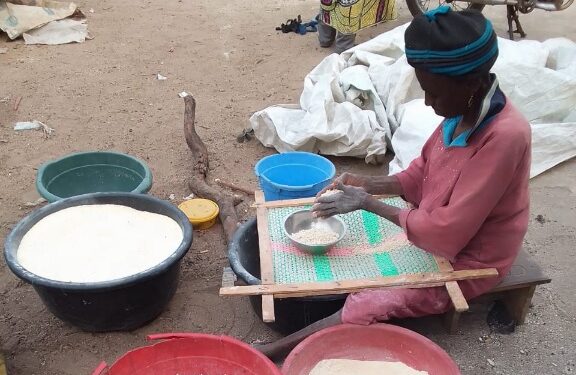
Like all food items, the price of garri has jumped up by over 100 percent in the last few weeks adding to the burden of average Nigerians. YEJIDE GBENGA-OGUNDARE speaks with stakeholders in the food chain on why garri is no longer a staple for low-income earners.
Demand for garri is not only local; there is an international demand for the product.
Nigerian Diaspora communities also maintain a demand for garri as an essential part of their culinary heritage and Nigerian grocery stores in these communities often import garri to meet this demand, putting a more burden on local consumers as distributors who make more from this prefer to sell out of the country.
Abimbola Shakur, a garri distributor who sells to retailers at Bodija market told Saturday Tribune that those that export make it more expensive for local sellers.
According to him, “there is a high demand for garri by our people abroad and some distributors prefer to sell to exporters. Garri is popular in some African countries with similar food preferences too, and we all buy from same source, so while we are looking at how to minimise cost in relation to other factors like transportation, the exporters don’t care. They will always get their money
“So while you are still negotiating price, they will just buy and because the processor also wants as much profit as possible, once they buy, that becomes the price. They prefer to sell to them more than to us. As a result, when there is limited product because of issues like cassava production fluctuations because of harsh weather or insecurity in the farms, it is survival of the fitted, the person with more money to drop gets he product. This affects prices,” he added.
Why garri is now expensive
The price of garri like other food items is influenced by a variety of factors both internal and external factors. Idris Adegoke, a farmer whose plantation is at the Ijaiye farm settlement stated that price of cassava is a major factor that determines the price of garri, adding that shortage of cassava in the market can drive up the price of garri.
According to him, “weather condition is also a huge factor; droughts or excessive rainfall affect cassava production because unfavorable weather conditions can reduce the supply of cassava, leading to higher garri prices. Also, the cost of processing cassava into garri is a determinant. When we talk of factors like transportation, labor, energy or equipment, rising processing costs will definitely lead to higher retail prices. You know people buy cassava from farms and mine is far from town like many others, the pay for transport. Also, garri is often produced in rural areas and transported to urban centers and with this increase in fuel prices, transportation costs are over the roof and they lead to higher garri prices in urban areas.”
Another farmer, Adepegba Ajagbe said, “Weather condition is a great factor. The rainy season can affect cassava cultivation. Excessive rainfall can lead to difficulties in harvesting and processing cassava roots, which can reduce the supply of cassava and potentially increase garri prices and the dry season can also impact garri prices. During this season, cassava roots can become scarcer, leading to increased prices.”
Dosu Aina, a food technologist said the basic principle of demand and supply play a significant role as increase in demand for garri when production is low can push prices higher if supply does not keep up. He added that “we all know that there is inflation now and the economic life of all Nigerians is affected. Garri which is the common man’s food is consequently in high demand and I do not think production is meeting up with demand especially due to so many factors, including those that smuggle food to neigbouring African countries. Food that is not enough for us is smuggled out and when we can’t meet local demand, it tells on price.
“We should also remember that economists have said that inflation in the economy can erode the purchasing power of consumers. We all know that take home pay can no longer take many people home today, the reduction in purchasing power is making garri more expensive,” he added.
A garri seller who identified herself as Mama Ada told Saturday Tribune that market location affects garri prices as it varied based on where you are buying from based on people that live within the area and transportation costs among other factors.
She added that “when people think the area where they sell is inhabited by rich people, their pricing method changes. Imagine this garri Iwo that I sell at N900 a kongo is sold at N1200 at Basorun market, even garri that is not as good as this that should not cost more than 800 is sold at N1000 by many. The truth is we as a people add to the burden of the country. People just fix price arbitrarily and hide under things are expensive, we add to the problem.”
Other uses
It was also gathered that the use of cassava for other food items has made it to be more in demand and has reduced the volume that is used for garri. Benedict Oni, a market analyst said, “The fact that cassava which is the main product used to process garri is now used in the production of various products like starch, ethanol, flour, glucose syrup and sweeteners in large quantities will affect price because you now buy cassava at higher prices.
“The uses for cassava are now unlimited; it is also used as raw material by numerous industries and it has limitless domestic and export market potential. In addition, flour millers now blend it in high volumes to produce wheat; we should also not forget that insecurity has pursued many farmers from the plantation, reducing seriously the volume of garri produced,” he added.
Current market price
Saturday Tribune investigations revealed that where you are buying garri not only determines price but also the quantity. A sack of garri contains 102 kongos or 100, depending on the type of kongo you use, whether the normal one or stylishly reduced one. A bag of garri Iwo or garri Oyo sells between N82, 000 to N85, 000 while a bag of garri egba sells between N100, 00 to N105, 000.
There are 24 paint buckets in a small bag of garri while the big bag of garri contains 43 paint buckets; a complete bag of garri contains 215 derica, while a small bag of garri contains 120 derica. Also, there are 43 paint rubber buckets in a 50kg bag of garri. A 50kg bag of garri contains 960 cups which is equal to 120 mudus.
Some sell garri in large baskets that contains 16 kongos and this is sold between N12,000 and N15,000 depending on the market. Yellow garri is also a bit more expensive than the white one but the difference is usually not more than N3000 across the markets. The average price of a 50kg bag of yellow garri is ₦45,000 while the average price of a 50kg bag of white garri is ₦43,000
A distributor gave price for garri ijebu as: N900 for 1kg, N4,500 for 5kg, N9,000 for 10kg, N23,000 for 25kg, N45,000 for 50kg, N90, 000 for 100kg and N900, 000 for a ton.
Garri, made from cassava tubers which is a drought-tolerant and widely cultivated crop in Nigeria, is a popular staple food in Nigeria and it is one foods that cut across almost all ethnic in Nigeria. It also holds appeal for many as it is considered a comfort food that is enjoyed by people of all ages. And because it is processed by many people in various quantities and has a high demand, garri, aside from being a fast source of food, especially to students, is of great importance as it is the source of livelihood for many people; small-scale farmers, processors and sellers.
The fact that garri can be taken without much ceremony, has a long shelf life and does not need any special preservation process and is a versatile food product that is easily available, `even to low income earners, makes it one of the most important, easy to access and affordable source of food.
Indeed, it is seen as the food for the common man as people doubt its nutritional value because while it has been proved to be a good source of carbohydrates and dietary fiber with dense energy to provide sustenance in areas where food security is a concern, it is low in protein and other essential nutrients, so it is often consumed with other foods to create a balanced meal.
And it is avoided by people watching their diet for weight management but a hit with people who have weak financial abilities as it is not only readily available but also arguably, one of the cheapest staple
But that is in the past. Garri can no longer be called a poor man’s food as it has fast gone beyond even the means of many medium bracket earners; market surveys have shown a steep increase in the price of garri like other major food items but the effect of increase in garri seems to be felt more because aside being consumed in many households in the country, what used to be the food of the common man has gone way beyond their reach and the poor can no longer enjoy their garri.
While Nigeria is one of the largest producers and consumers of garri, the production is decentralised with many small-scale producers and distributors scattered across the country. Indeed, the industry is highly fragmented and many small-scale producers and distributors are not known beyond their immediate circle, making it a difficult industry to regulate.
Major garri producing communities
While garri is produced in diverse quantities across Nigeria, even in people’s backyard for personal consumption and sometimes local sale to friends and family, there are some prominent states in Nigeria known for garri production with identified small-scale garri processing units and distributors.
Such states include Ekiti with massive small-scale garri processing units and distributors, Delta is known for its high-quality garri production especially in communities like Warri and Ughelli. Ogun is well-known garri brands especially in places like Ijebu-Ode. In Oyo State, garri processing units and distributors can be found in various parts, making the state a significant player in garri production and distribution. Also, Iwo in Osun state is known for good garri among distributors, Anambra State has a significant garri production industry with the garri from this region known as “Nri-Awgu” garri and Benue State, which also has a growing garri production and distribution sector.
Also, the largest garri distribution units have been identified as Lagos and Oyo States; Lagos, as Nigeria’s commercial hub, has garri distributors and retailers serving both local and urban markets while Ibadan, the capital city of Oyo State, is also a major distribution point for garri.
TRIBUNE







